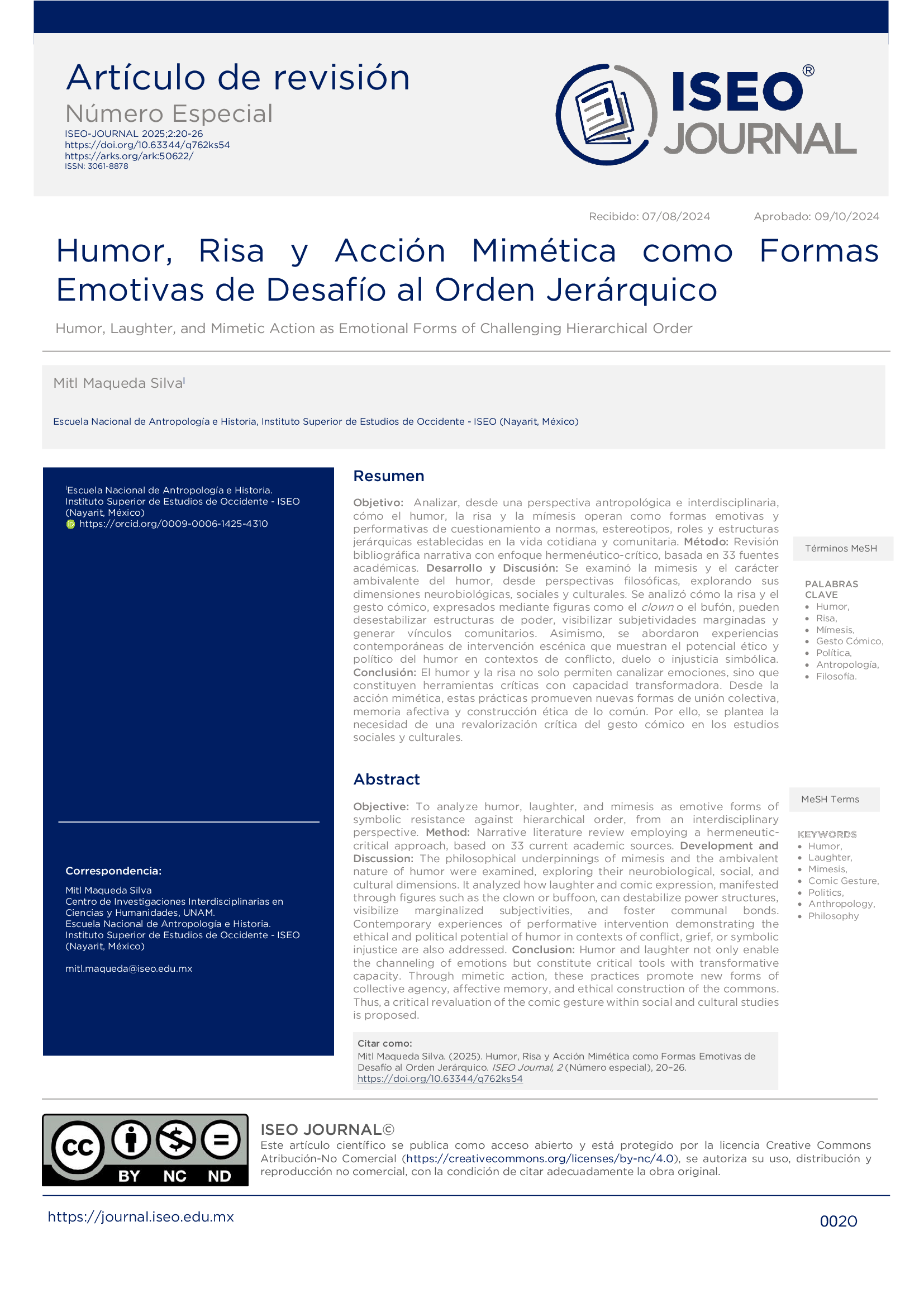Humor, Laughter, and Mimetic Action as Emotional Forms of Challenging Hierarchical Order

Published 2025-07-31
Keywords
- Humor,
- Laughter,
- Mimesis,
- Comic Gesture,
- Politics
- Anthropology,
- Philosophy ...More

This work is licensed under a Creative Commons Attribution-NonCommercial-NoDerivatives 4.0 International License.
How to Cite
Abstract
Objective: To analyze humor, laughter, and mimesis as emotive forms of symbolic resistance against hierarchical order, from an interdisciplinary perspective. Method: Narrative literature review employing a hermeneutic-critical approach, based on 33 current academic sources. Development and Discussion: The philosophical underpinnings of mimesis and the ambivalent nature of humor were examined, exploring their neurobiological, social, and cultural dimensions. It analyzed how laughter and comic expression, manifested through figures such as the clown or buffoon, can destabilize power structures, visibilize marginalized subjectivities, and foster communal bonds. Contemporary experiences of performative intervention demonstrating the ethical and political potential of humor in contexts of conflict, grief, or symbolic injustice are also addressed. Conclusion: Humor and laughter not only enable the channeling of emotions but constitute critical tools with transformative capacity. Through mimetic action, these practices promote new forms of collective agency, affective memory, and ethical construction of the commons. Thus, a critical revaluation of the comic gesture within social and cultural studies is proposed.
Downloads
References
- Aristóteles. (1974). Poética. Gredos.
- Benito Torres, J. (2024). La noción de mímesis en la filosofía platónica: Imagen y terapia entre el arte y la ética. Isegoría: Revista de Filosofía Moral y Política, (70), 1347. https://doi.org/10.3989/isegoria.2024.70.1347
- Bryant, G. A., & Bainbridge, C. M. (2022). Laughter and culture. Philosophical Transactions of the Royal Society B: Biological Sciences, 377(1853), 20210179. https://doi.org/10.1098/rstb.2021.0179
- Casado Muñoz, I. (2017). El humor desde las ciencias sociales. El humor como herramienta de resistencia en movimientos sociales. El caso del 15M. Perifèria: Revista de Recerca i Formació en Antropologia, 22(1), e513. https://doi.org/10.5565/rev/periferia.513
- Castillo Merlo, M. C. (2019). La noción de mímesis en la filosofía de Ricœur. Contrastes. Revista Internacional de Filosofía, 24(1), 59–82. https://doi.org/10.24310/Contrastescontrastes.v24i1.6703
- Dawkins, R. (1993). El gen egoísta: Las bases biológicas de nuestra conducta. Salvat Editores.
- Díaz Sandoval, A. (2023). Distanciamiento afectivo: Escenas y escenarios del arte contemporáneo. Religación, 8(38), e2301148. https://doi.org/10.46652/rgn.v8i38.1148
- Dunbar, R. I. M. (2022). Laughter and its role in the evolution of human social bonding. Philosophical Transactions of the Royal Society B: Biological Sciences, 377(1853), 20210176. https://doi.org/10.1098/rstb.2021.0176
- Fernández Poncela, A. M. (2022a). El humor agresivo: Causas, consecuencias, reflexiones y ética. Ciencias Sociales y Educación, 11(21), 102–127. https://doi.org/10.22395/csye.v11n21a5
- Fernández Poncela, A. M. (2022b). La teoría del alivio en el humor y la risa, un enfoque saludable [PDF]. Ecúmene de Ciencias Sociales, 5(1), 8–25. https://revistas.ensq.edu.mx/index.php/ecumene/article/view/39/38
- Figueroa, E. (1995). El humor en psicoterapia. Enfoques: Revista de la Universidad Adventista del Plata, 7(2), 50–54. https://dialnet.unirioja.es/servlet/articulo?codigo=7385139
- Freud, S. (1905). El chiste y su relación con lo inconsciente (2.ª ed.). Amorrortu.
- Gebauer, G., & Wulf, C. (1995). Mimesis: Culture, art, society (D. Reneau, Trans.). University of California Press.
- Ginzburg, J., Mazzocconi, C., & Tian, Y. (2020). Laughter as language. Glossa: A Journal of General Linguistics, 5(1), 104, 1–51. https://doi.org/10.5334/gjgl.1152
- Göpfert, M. (2022). On dictators and clowns. Anthropology Today, 38(2), 22–24. https://doi.org/10.1111/1467-8322.12729
- Guthrie, W. K. C. (1998). Historia de la filosofía griega. Volumen IV: Platón, el hombre y sus diálogos, primera época (Vers. esp. de Álvaro Vallejo Campos y Alberto Medina González) [PDF]. Editorial Gredos. https://seminariofsyp.wordpress.com/wp-content/uploads/2018/01/01-03-03-guthrie-w-k-c-iv-platon.pdf
- Guzmán Aguilar, F. (2022). La risa, asociada al humor, exclusiva del ser humano. Gaceta UNAM. https://www.gaceta.unam.mx/la-risa-asociada-al-humor-exclusiva-del-ser-humano/
- Laaksonen, S.-M., Koivukoski, J., & Porttikivi, M. (2022). Clowning around a polarized issue: Rhetorical strategies and communicative outcomes of a political parody performance by Loldiers of Odin. New Media & Society, 24(8), 1912–1931. https://doi.org/10.1177/1461444821989621
- López Peñuelas, P. J., & Brenscheidt genannt Jost, D. (2017). La etnografía de performance como herramienta para la investigación en artes escénicas. Psicumex, (5), 33–43. https://www.redalyc.org/articulo.oa?id=667877071004
- Marín Mira, Y. (2023). El clown como estrategia de intervención social en el proyecto AIRE. Estudios Artísticos: Revista de Investigación Creadora, 10(14), 62–74. https://doi.org/10.14483/25009311.20666
- Melberg, A. (1995). Theories of mimesis. Cambridge University Press.
- Merlo, M. C. (2015). Acerca de la relación mímesis-mûthos en la Poética de Aristóteles: En torno a los criterios de necesidad y verosimilitud. Tópicos, Revista de Filosofía, 48, 201–224. https://doi.org/10.21555/top.v0i48.690
- Naranjo Velásquez, S. (2015). Aproximación al concepto de antropología teatral según Eugenio Barba. Revista Colombiana de Artes Escénicas, 9, 206–223. https://revistasojs.ucaldas.edu.co/ index.php/artescenicas/article/view/9095
- Navarro González, J. L., & Melero, A. (Eds. y Trads.). (1981). Herodas: Mimiambos o fragmentos mímicos. Partenio de Nicea: Sufrimientos de amor. Editorial Gredos.
- Platón. (1986). Diálogos IV: República (C. Eggers Lan, Trad.). Editorial Gredos.
- Preziosa, M. M. (2022). La mímesis según René Girard y la toma de decisiones éticas en la empresa. Veritas, (52), 53–71. https://www.scielo.cl/scielo.php?script=sci_arttext&pid=S0718-92732022000200053
- Rodríguez Migueles, E. de J. (2015). La filosofía extraviada: El lugar de la risa en la cultura. Estudios Políticos (México), (34), 37–63. http://www.scielo.org.mx/scielo.php?script=sci_arttext&pid=S0185-16162015000100003
- Ruch, W., Platt, T., Proyer, R. T., & Chen, H.-C. (2019). Editorial: Humor and laughter, playfulness and cheerfulness: Upsides and downsides to a life of lightness. Frontiers in Psychology, 10, 730. https://doi.org/10.3389/fpsyg.2019.00730
- Sakai, T. (2022). Humour and the plurality of everyday life: Comical accounts from an interface area in Belfast. Social Anthropology/Anthropologie Sociale, 30(1), 143–160. https://doi.org/10.3167/saas.2022.050402
- Salvat, R. (1983). El teatro, como texto, como espectáculo. Montesinos.
- Scaramuzzo, G. (2016). Aristotle’s homo mimeticus as an educational paradigm for human coexistence [PDF]. Journal of Philosophy of Education, 50(2), 246–260. https://www.postgradoteatroeducacion.com/wp-content/uploads/2017/05/Article-Journal-of-Philosophy-of-Ed..pdf
- Velásquez, A. M., & Martínez, M. (2021). La intervención social de clown, una práctica dispositiva de investigación-creación para la construcción de paz en Colombia. Corpo Grafías: Estudios Críticos de y desde los Cuerpos, 8(8), 137–149. https://doi.org/10.14483/25909398.19081
- Von Barloewen, C. (2016). Clown: Una figura arquetípica. Ediciones Kairós.
- Weiz Carrington, G. (1998). Dioses de la peste. Un estudio sobre literatura y representación [PDF]. UNAM / Siglo XXI Editores. https://publicaciones.umich.mx/revistas/devenires/ojs/article/download/721/601/1413

